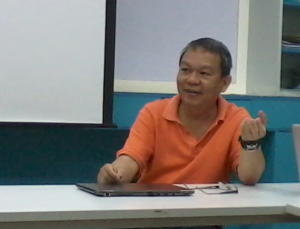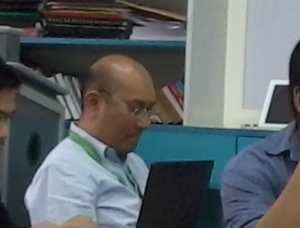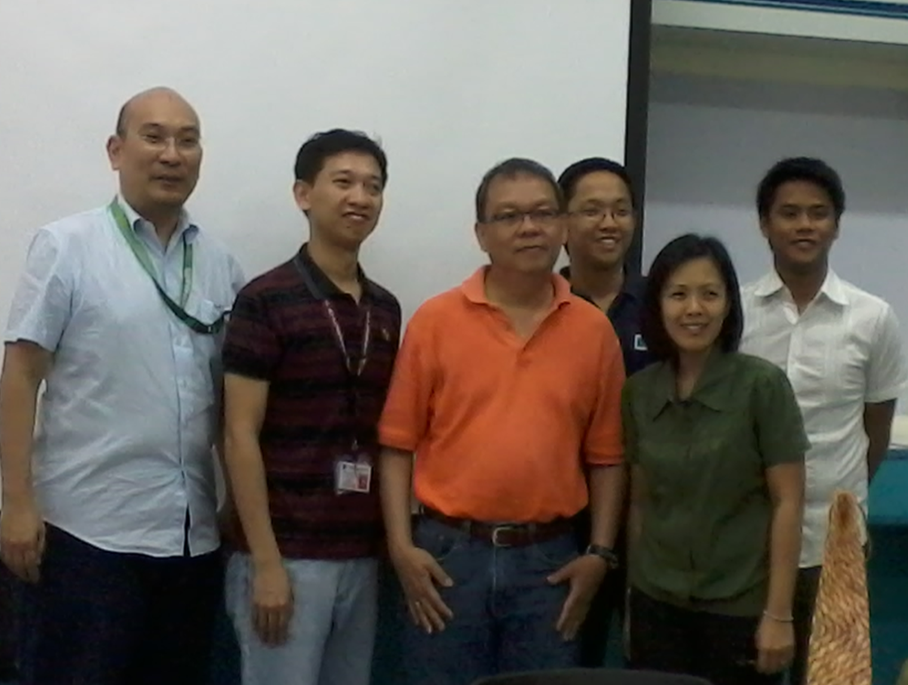The Man Who Started It All
April 26, 2012 9:09 am | by Aliyah Lou Evangelista | Posted in News
How Dr. Herman Tolentino’s single most important question in life defined the future of health centers today.
He entered the room like he was anybody else. His casual orange polo shirt and denim jeans made him look like he was also up to listen to some much awaited speaker of the room. He sat upfront as if he’s one among the crowd; smiled occasionally and glanced at every young person inside the room.

Dr. Herman Tolentino recounting the real story behind the creation of CHITS. In 2003, this man showed the Philippines that it is possible for non-computer users inside government health centers to be data managers using CHITS.
I heard and read about him many times during my undergraduate research way back college. When I landed a job at the National Telehealth Center, I thought I am going to meet him in person. However, when I learned that he’s Director of the Public Health Informatics Fellowship Program (PHIFP) at the Center for Disease Control and Prevention (CDC) in the US, I thought it was impossible to even have a glimpse of him.
I had the opportunity to set the mood of that sharing session. I know many of us were excited to learn a lot from this man. When it’s time for him to hit the stage and do the talking, he just sat with us, recounts the fascinating story of what would be the Philippines’ first electronic medical record system for government health centers-the Community Health Information Tracking System (CHITS).
From Passion to Purpose
Dr. Herman Tolentino graduated as a medical doctor in 1985 at the UP College of Medicine. In 1990, he had his residency at the Anesthesiology Section of the University’s general hospital. Though he was an anesthesiologist, putting people into sleep is not something he wanted to do for the rest of his life. According to him, it’s that single question that defined who he is now.
“When I started designing CHITS, I started a journey where (in the end), I found myself,” he said softly before the crowd, “I don’t really know much of the field then,” he added.
After learning that information systems could do so much in improving public health from those who have little to no access, Dr. Tolentino decided to dive in the emerging field of health informatics in the Philippines. In the course of his work, along with his friends Dr. Alvin B. Marcelo and Dr. Cito Maramba, both of the College of Medicine, he found that the real challenge on information systems is when you implement it down in the communities.
CHITS for health workers is envisioned to bring social justice on health. “Those who need health care most are those who least likely get it,” Dr. Tolentino said, quoting Julian Tudor Hart, a British physician –advocate of socialism on health care. He believes that his passion should lead him into narrowing the disparities in health care.

Dr. Alvin Marcelo seemingly busy reading emails in his phone was also at the sharing session at UP College of Medicine COMED Lecture Room. Dr. Marcelo was part of Dr. Tolentino's team when they developed CHITS
On Building Community Ownership
“Introducing a system to health workers is like walking on water,” he explained while sharing his experience in developing the codes of CHITS in PHP. In 2004, Dr. Tolentino and his team develop every module of CHITS in close consultation with nurses, midwives, and doctors at Lagrosa and Malibay Health Center in Pasay City. Dr. Tolentino types the codes and show how the system will work when some parts are clicked. Health workers comment and make sure that what will the product reflects the per patient data recording they do on paper.
“When you show them that you value their voice in creating the system, they will start to own it. You made them feel that it is them who actually create the system,” said Dr. Alvin Marcelo, one among those with Dr. Tolentino in developing CHITS.
When CHITS was crafted mid March, Dr. Tolentino and his team started training health workers on April of 2004. Midwives were quite afraid of using the computers. Most of them think that they might delete or damage files inside the computer. But through informal chats with health workers and honest evaluations on it, health workers have started ease in using it.
It was not a good system at all. But because it was built with the users, the users themselves have learned to cope up with its iniquities and work with its limitations.
CHITS Today
“You have to look for an interesting problem,” Dr. Tolentino advised every one of us in the room. “At CDC, I look for problems,” he added as he emphasized that working in the training and the system is a heavy task and the only way to improve it is to look for problems.
Project Coordinators of CHITS in Navotas, Quezon City, and in GIDA* communities shared recent developments on CHITS. Arturo M. Ongkeko, Jr., CHITS Coordinator in Navotas told Dr. Tolentino on innovative CHITS applications for monitoring maternal and child health indicators while JR Gavino, CHITS Coordinator in QC, laid challenges in large-scale implementation of CHITS in QC. Dr. Geohary Hamoy, rCHITS Project Manager, explained how CHITS is being developed for far flung communities who usually have limited access to electricity and internet connection.
The session ended with the usual token and certificate-giving. As I look at people taking pictures of him, I know deep inside, it is not just me who’s asking “Why I am in this field?”. Dr. Tolentino’s story set engines on the noble work of health workers. More importantly, it gave me a sense of being that technology could help bridge the gap on quality health care service for those who needed it most.

Dr. Alvin Marcelo, Noel Banez, Dr. Herman Tolentino himself, Arturo Ongkeko, Jr., Dr. Marie Irene Sy, JR Gavino-CHITS Capacity Building Team
*Geographically Isolated and Disadvantaged Areas